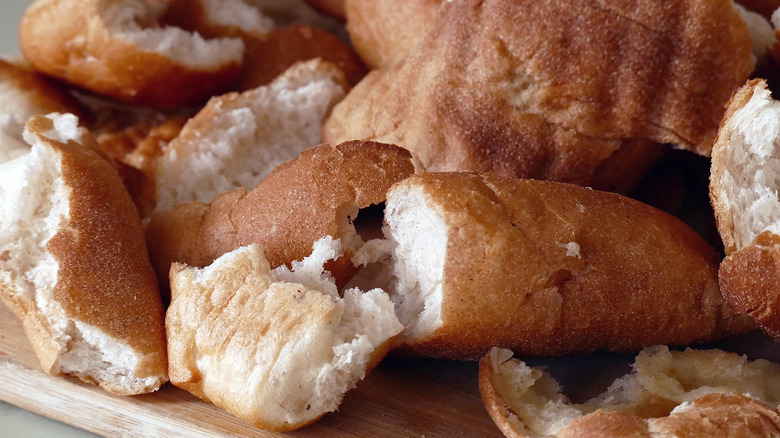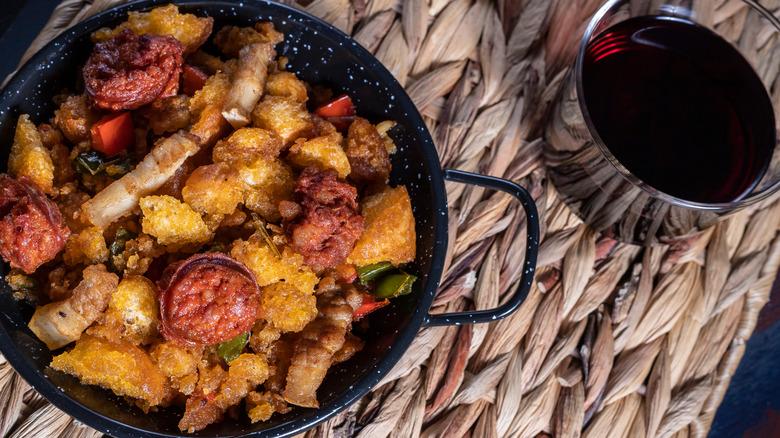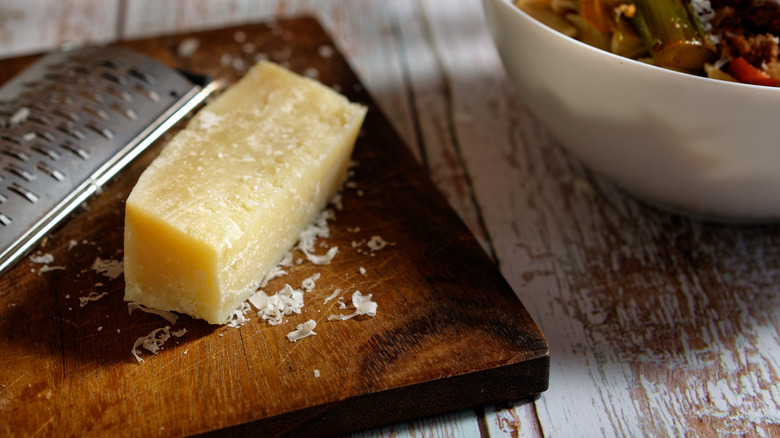Why Stale Bread Is A Go-To Ingredient For José Andrés
It's hard to understate the impact Chef José Andrés has had on the food world. Not only is he a hugely respected chef and restaurateur in his own right with two Michelin stars to his credit, but his charity, World Central Kitchen, has earned respect and accolades in the humanitarian sector for providing food disaster relief in crisis areas worldwide. Safe to say, he knows a thing or two about how important good food is, no matter how limited your resources.
Case in point: Andrés posted a home cooking video to X, formerly known as Twitter, as part of his Recipes for the People series made during the coronavirus pandemic in 2020, in which he demonstrates one incredibly simple Spanish dish that turns stale bread into a star ingredient that's full of flavor. The 10-minute dish Andrés makes is migas, which means "breadcrumbs" in Spanish.
To make migas, you break stale bread into chunky crumbs, sprinkle them with a little water, fry them with plenty of oil and salt until they're golden, add in any other ingredients you want to include, and serve accompanied by a fried egg. The crunchy croutons absorb all the oil and flavors in the pan, and the result is a taste sensation. Andrés notes in his video that Spanish people would insist on including chorizo in migas but says you can swap this for leftover meat or leave it out entirely if you want.
Other reasons to love stale bread
The uses for stale bread don't end with migas. From Spain alone, there are a host of other classic, comforting dishes that can be made using stale bread. There are all kinds of soups, from sopa de ajo to a refreshingly cool gazpacho or salmorejo, but there's also the utterly delicious torrijas, which bring condensed milk and stale bread together in an explosion of desserty deliciousness. Meanwhile, in neighboring France, you'll find the torrijas' more breakfast-leaning cousin, Pain perdu, or French toast. There's also classic French onion soup, where stale bread serves as a vessel for a melted cheese topping while absorbing the flavorsome oniony soup below.
Alternatively, you can confront leftover bread with a functional approach. Breaking it into large crumbs, coating them in oil, salt, and herbs, then roasting them in the oven until they're golden will provide you with delicious croutons. When stored in an airtight container, these last about a week in the fridge and can be used across a range of recipes. Croutons are particularly useful in salads, where they add crunch and saltiness. Italian Panzanella and Levantine fattoush are both well-known salads that use stale bread this way. So, stale bread can be revitalized by being fried in oil or rehydrated with a liquid, but thanks to its starchiness, it's also useful as a secret ingredient for thickening soups and sauces.
More leftover ingredients to use in your kitchen
There are many mind-blowing facts about food waste in the U.S. that demonstrate just how serious the issue is, but reducing your food waste at home can be as simple as knowing what can be made with your leftover ingredients. Use leftover bones from pretty much any animal to create part of your next meal by learning the basic principles of making stock. Another common sight in garbage bins is vegetable peel; these too can be used in your homemade stock, but they also work as a nutritious snack when dried, tossed in oil and salt, and roasted to make vegetable peel chips. Another potential leftover for a stock or a soup is cheese rinds, with parmesan rinds in particular capable of adding depth of flavor to a vegetarian bolognese.
Believe it or not, eggshells can be boiled, dried, and blended to form a white calcium powder. This can be added to food or drink as a flavor-neutral supplement or mixed with salt or spices to create a flavorsome seasoning. When reducing food waste and turning ingredients like stale bread into something as simple but delicious as Chef José Andrés' migas, the limit is only your knowledge and creativity. Even something as typically discarded as a banana peel can be turned into appetizing food or put to some other use at home.


